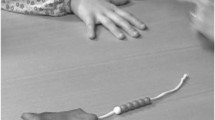Abstract
First- and second-grade children were successfully taught symbolic multi-digit addition and subtraction procedures by first doing the procedures with a physical embodiment of the first four places of the base-ten system. Relationships between the embodiment and the numerical symbols were supported by close linking of the physical and the symbolic procedures and by the use of base-ten, named-value (standard English), and embodiment-name words. Most children successfully extended the procedures to ten-digit symbolic problems done without the embodiment. For many children who made procedural errors on delayed tests, the mental representation of the procedure with the physical embodiment was strong enough for them to use it to selfcorrect their symbolic procedure. The physical embodiment also seems to support the learning of various other concepts related to place value.
Résumé
Des enfants de CP et CE1 ont appris les procédures d’addition et de soustraction à plusieurs chiffres en commençant par des manipulations physiques de différents blocs (cubes et buchettes de différentes formes et tailles) représentant les quatre premières places du système de base dix. Les relations entre la manipulation physique et celle des symboles numériques étaient assurées par l’utilisation conjointe des deux activités et la mise en correspondance des termes utilisés dans l’une et l’autre (nom des chiffres, nom des places en base dix, nom des objets représentant ces places). La plupart des enfants sont parvenus à généraliser leurs procédures de calcul à des opérations comportant dix chiffres et cela sans manipulations physiques. Pour la plupart des enfants ayant commis des erreurs aux épreuves de généralisation, la persistance de la représentation mentale des procédés de manipulation physique, constitua une aide efficace pour l’auto-correction de leurs erreurs de calcul symbolique. La concrétisation utilisée lors de la manipulation semble également favoriser l’apprentissage de nombreuses autres notions relatives à la valeur des places occupées par les chiffres dans les nombres sujets à des opérations arithmétiques.
Similar content being viewed by others
References
Bell, M. B., Fuson, K. C., & Lesh, R. L. (1976).Arithmetic and algebraic structures: A concrete approach for elementary school teachers. New York: Maemillan.
Dienes, Z. P. (1960).Building up mathematics, London: Hutchinson Educational Ltd.
Fuson, K. C. (in press). Teaching children to subtract by counting up.Journal for Research in Mathematics Education.
Fuson, K. C. (1985).Teaching an efficient method of addition. Paper presented at the Annual Meeting of the American Educational Research Association, Chicago.
Fuson, K. C., & Hall, J. W. (1983). The acquisition of early number word meanings: A conceptual analysis and review. In H. P. Ginsburg (Ed.),Children’s mathematical thinking (pp. 49–107). New York: Academic Press.
Fuson, K. C., Richards, J., & Briars, D. J. (1982). The qcquisition and elaboration of the number word sequence. In C. J. Brainerd (Ed.),Progress in cognitive development: Vol. 1. Children’s logical and mathematical cognition (pp. 33–92). New York: Springer-Verlag.
Fuson, K. C., & Stigler, J. (1986).Grade placement of addition and subtraction topics in China, Japan, the Soviet Union, Taiwan, and the United States. Unpublished manuscript, Northwestern University.
Hall, J. W., Fuson, K. C., & Willis, G. B. (1985). Teaching counting on for addition and counting up for subtraction. InProceedings of the Ninth Annual Meeting of the International Group for the Psychology of Mathematics Education. Noordwijkerhout, The Netherlands.
Hutchings, B. (1975). Low-Stress Subtraction.The Arthmetic Teacher, 22, 26–232.
Underhill, R. (1984). External retention and transfer effects of special place value curriculum activities.Focus on Learning Problems in Mathematics, 1&2, 108–130.
Author information
Authors and Affiliations
Additional information
This research was funded by the Amoco Foundation. Sincere thanks go to Maureen Hanrahan for interacting with the teachers so sensitively and intelligently, to the teachers for trying something new and for doing it so well, and to the children, who loved adding and subtracting big numbers and understanding what they were doing.
Rights and permissions
About this article
Cite this article
Fuson, K. Roles of representation and verbalization in the teaching of multi-digit addition and subtraction. Eur J Psychol Educ 1, 35–56 (1986). https://doi.org/10.1007/BF03172568
Received:
Revised:
Published:
Issue Date:
DOI: https://doi.org/10.1007/BF03172568




